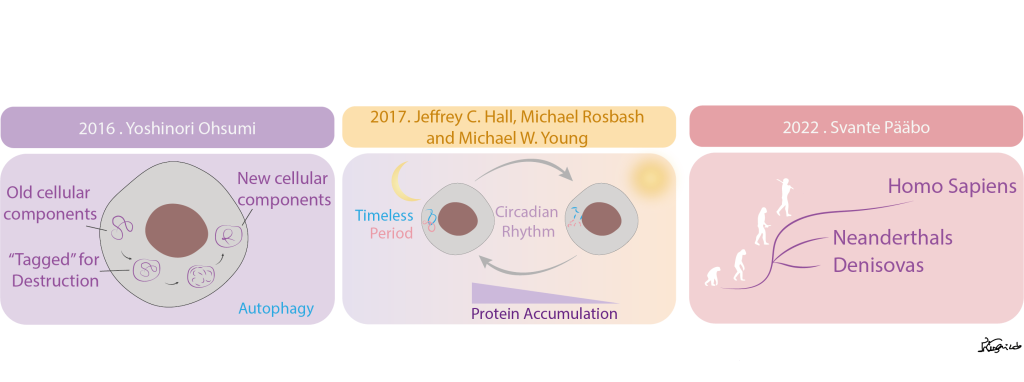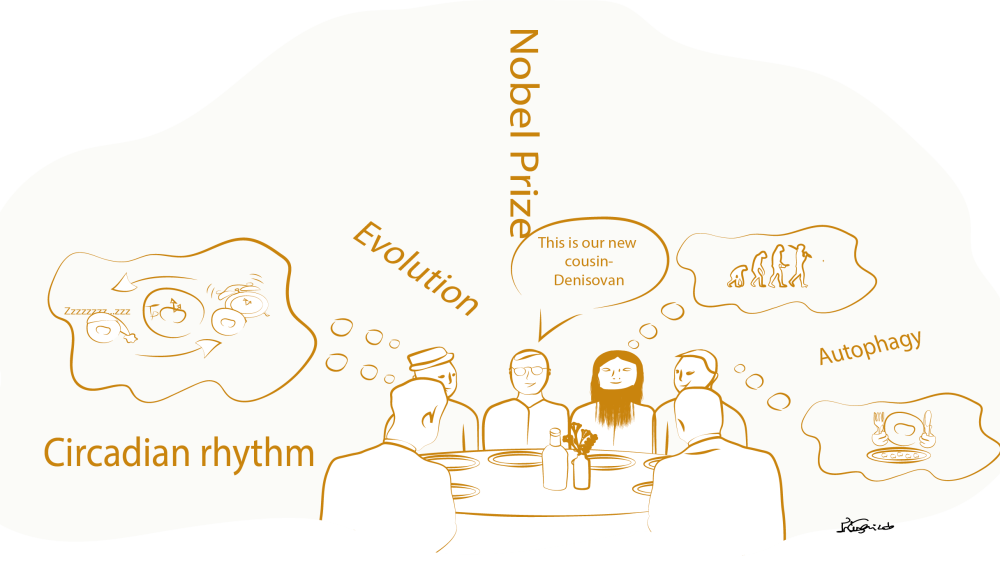In the middle of all the holiday festivities, last week was particularly important in science. Between snowflakes falling all over the world, Mariah Carey echoing through the ear canals of millions and millions of people, the Nobel Prize Award Ceremony took place last Sunday, the 10th of December. During this big event, eleven laureates were awarded for their accomplishments that have benefited humanity so much. And still, we haven’t figured out a way of communicating the sense of smell through computers or smartphones… Maybe next year. The ceremony took place at the Stockholm Concert All, after what we assume might have been a nice dinner with unpronounceable dishes. As a way to celebrate this day, here in the Science As We Know It, we propose you come with us through a brief overview of some of the recent Nobel Prizes in Physiology or Medicine. On the menu today we have: evolution, the organism’s internal clock and cells eating themselves. You are welcome to have a small taste of each of them.
2016 – Yoshinori Ohsumi “for his discoveries of mechanisms for autophagy”
“Autophagy” means “to self-eat”. And although this might sound cannibalistic, it is actually a very smart mechanism through which cells can adapt to extreme conditions, like starvation or infection.
Yoshinori Ohsumi’s groundbreaking studies identified genes that are essential for autophagy. By using yeast (because of their simplicity), Ohsumi and his team characterized different events that take place during the autophagy process: how stress signals give the cell the cue to initiate the formation of the vesicles that will engulf some of the cellular components. These will then be recycled to provide the cell with what it needs.
By degrading some of its own inner components, although causing some self-harm by losing them, the cell is able to rapidly get some more building blocks for renewing other components that might be more important at that time. It’s like we chose to destroy a cookie factory to get some materials to build a huge protective wall in case of an alien invasion. Cookies are nice, I know. But if an alien species is trying to conquer your planet, maybe our priorities need to be changed (Apocalyptic scenarios are always fun, aren’t they?).
2017 – Jeffrey C. Hall, Michael Rosbash, and Michael W. Young “for their discoveries of molecular mechanisms controlling the circadian rhythm”
You are probably aware that your body seems to have its internal way of telling time. Maybe you are able to wake up at a specific time, even though you set no alarm (or on weekends, when you really really reeeally don’t need to).
The 2017 Nobel laureates looked under the hood and unveiled the mechanism through which a key protein named “Period”, in an intricate system involving other proteins named “Timeless” and “Doubletime”, accumulates inside the cell during nighttime and is then degraded during the day.
This oscillation throughout 24 hours is, therefore, the reason why cells are “aware” of time.
Besides the creativity in naming these proteins – we have to admit – these were also pioneering discoveries leading to a better understanding of our intracellular clockwork. Our biological clocks regulate so many different things like metabolism, hormone levels, or sleep. Now you know why you felt jet-lagged after traveling to distant time zones.

Figure 1- Illustration for the Nobel Prizes in Physiology and Medicine, 2016, 2017 and 2022. In 2016, Yoshinori Ohsum was awarded the Prize for his discoveries in autophagy, a process where cells “eat” old cellular components to renew them. Jeffrey C. Hall, Michael Rosbash and Michael W. Young won in 2017, for describing the proteins and cellular processes that control the circadian cycle. In 2022, Svante Pääbo was awarded the Prize for his studies in Human evolution and the discovery of a Denisovan.
2022 – Svante Pääbo “for his discoveries concerning the genomes of extinct hominins and human evolution”
Where do we come from? What is our story? These are 2 essential questions every now and then we might ask ourselves. Svante Pääbo went a little bit further and tried to figure out not only his past but the history of all humans. We, modern humans, or as scientists like to call Homo sapiens, have been here for 300,000 years (despite the word modern don’t get confused, this means humans with our physical features, not humans carrying phones everywhere). However, before us, there were other relatives very close to what we might call a human now, like Homo erectus. More interesting, other relatives were co-existing with us, the Neanderthals. This raises several questions: Why have our relatives gone extinct? If we co-exist with Neanderthals, were we interacting with each other? Well, as you can imagine my dear reader, this is not easy to understand as our relatives went extinct. All we have to tell us about our past is ancient bones and teeth. This is where Svante Pääbo entered in scene, taking advantage of multiple lab technologies, Pääbo and his team made it possible to analyze DNA from those old bones*. Why is this so important? Multiple years after body death there is only very few amounts of DNA that we can take and analyze. Now we know that some percentage of Neanderthal DNA is present in today’s humans, meaning that at some point Neanderthals and Homo sapiens mate. We understand better how our immune system (the system we have to fight bacteria and viruses) adapted and survived to new environments while we were spreading through the entire world and finally, we discovered another relative that existed at the same time as us- Denisovan (Ah! The classic big family dinner, where you find out that you have another cousin).
*In this post, we refer to nuclear DNA, as we will later explain to you other DNAs exist, which were explored in the first evolution studies by Allan Wilson.


Blue Techker
Blue Techker I’m often to blogging and i really appreciate your content. The article has actually peaks my interest. I’m going to bookmark your web site and maintain checking for brand spanking new information.
put real estate in the mix nar realtormagazine
allegheny county real estate I truly appreciate your technique of writing a blog. I added it to my bookmark site list and will
URL Shortener
Hello, Jack speaking. I’ve bookmarked your site and make it a habit to check in daily. The information is top-notch, and I appreciate your efforts.
random email
Hi there to all, for the reason that I am genuinely keen of reading this website’s post to be updated on a regular basis. It carries pleasant stuff.